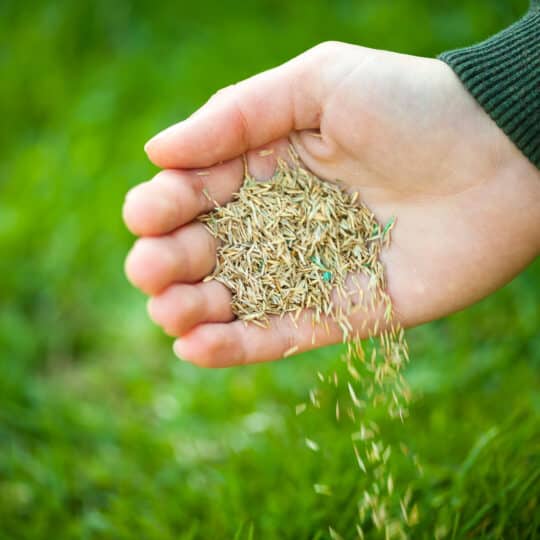Spring Lawn Overseeding
Bringing Your Lawn Back to Life
Posted
April 6, 2023

Now that it’s spring, you should see your lawn start to bounce back from dormancy. Not only does it start growing again, but it should be getting greener and more lush. If it’s not and you notice brown spots and bare areas there’s still hope for revitalization. Spring lawn overseeding is one way to help it recover from any winter damage. Here’s how.
Choosing the Right Seed
Before you start spreading the seeds, evaluate the type of lawn you have and think of the type of lawn you want. If you prefer a pristine look, choose a mix like Kentucky Bluegrass. Some grasses are more durable to high-traffic, so if you have kids and pets, choose a more robust mix.
Also keep in mind the environment you live in. There are warm-season and cool-season grasses that thrive in certain climates. Not all grasses grow well in shaded areas either, so research which type of grass is best for your yard.
Spring Lawn Overseeding
Winter can take a toll on your grass. Between the cold and any excessive traffic, the blades may not bounce back as quickly once the weather warms. There’s a way to jumpstart the process in early spring. Don’t wait until the summer, since that’s another season when grass can go dormant. You also don’t want to waste your efforts in the winter while the grass isn’t actively growing.
Follow these steps for overseeding your lawn to help repair bare or thinning spots of grass. Not only does this help improve the look of your lawn, but it makes it harder for weeds to grow instead.
- Mow. First thing you want to do is cut the grass. This helps you see which areas are more in need of seed. Collect the grass blades to keep your lawn clear of debris. If you want, toss the clippings in a compost pile to use as garden mulch.
- Rake. Use a lawn rake to break up any areas of thatch, dead grass, moss, and weeds.
- Aerate. Not only does this help improve ground compaction, drainage, and ventilation, but it also creates pathways for grass seeds to come in contact with the soil.
- Fertilize. Give the existing grass a boost by feeding it fertilizer. Be sure to choose a product formulated for spring use. This is typically more nitrogen-rich than other products. There are even some weed and feed products that help prevent weeds from growing while promoting healthy grass growth. After application, water it into the soil and then wait a few days before spreading the grass seed.
- Overseed. After you’ve given your grass a break for a few days, it’s time to seed. Check the product instructions for the application amount and process. Make sure you spread the seeds evenly and it comes in contact with the soil.
- Water. Try to keep the newly seeded soil damp until you see signs of germination. Water immediately after spreading the seeds and then regularly for the next few days—it helps if you schedule seeding around some forecasted rainy days.
- Protect. Want to speed the germination process? Cover the seeded area with hay or landscape netting to help keep the seeds in place and prevent the wildlife from feasting. Remove any covering once the grass is growing steadily.
Maintaining a Healthy Lawn
Once your grass bounces back, celebrate by continuing to keep it healthy! Regular mowing, watering, and fertilizing helps maintain healthy grass which will keep it strong in harsher weather. There’s no guaranteeing you won’t have to overseed again in the future, but being proactive about lawn care certainly puts the odds in your favor.
Special Offer for New Customers
Two Free Lawn Care Treatments
Hurry! Offer Expires July 31, 2024